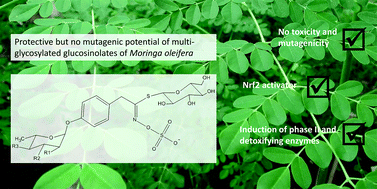Characteristic single glucosinolates from Moringa oleifera: Induction of detoxifying enzymes and lack of genotoxic activity in various model systems†
Abstract
Leaves of Moringa oleifera are used by tribes as biological cancer medicine. Scientific investigations with M. oleifera conducted so far have almost exclusively used total plant extracts. Studies on the activity of single compounds are missing. Therefore, the biological effects of the two main aromatic multi-glycosylated glucosinolates of M. oleifera were investigated in the present study. The cytotoxic effects of M. oleifera glucosinolates were identified for HepG2 cells (NRU assay), for V79-MZ cells (HPRT assay, SCE assay), and for two Salmonella typhimurium strains (Ames test). Genotoxic effects of these glucosinolates were not observed (Ames test, HPRT assay, and SCE assay). Reporter gene assays revealed a significant increase in the ARE-dependent promoter activity of NQO1 and GPx2 indicating an activation of the Nrf2 pathway by M. oleifera glucosinolates. Since both enzymes can also be induced via activation of the AhR, plasmids containing promoters of both enzymes mutated in the respective binding sites (pGL3enh-hNQO1-ARE, pGL3enh-hNQO1-XRE, pGL3bas-hGPX2-mutARE, pGL3bas-hGPX2-mutXRE) were transfected. Analyses revealed that the majority of the stimulating effects was mediated by the ARE motif, whereas the XRE motif played only a minor role. The stimulating effects of M. oleifera glucosinolates could be demonstrated both at the transcriptional (reporter gene assay, real time-PCR) and translational levels (enzyme activity) making them interesting compounds for further investigation.


 Please wait while we load your content...
Please wait while we load your content...